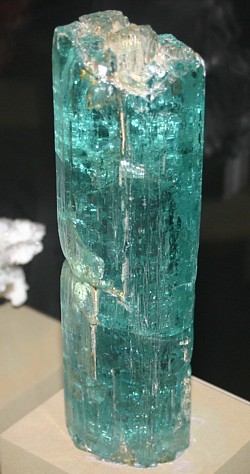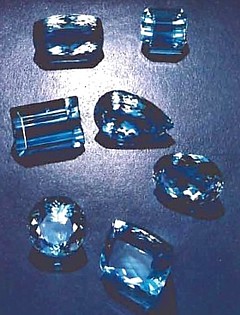AQUAMARINE - The Gem of the Sea
Aquamarine,
the "gem of the sea", derives its name from the ancient term for "sea water". The reference
is obvious: aqua sparkles like the sea and its color is pale to medium blue, sometimes
trending to a light green color. Aquamarine is the birthstone for March. Aquamarine is
always a pastel blue to blue green, but the darker the color, the more valued it is. Many
folks prefer a pure blue shade, with no green in it, however the greenish colors are also very
beautiful.
It is a
relatively hard gemstone, 8 on the Mohs scale and possesses moderate brilliance. Because
the color is generally pale, aquamarine should have a good clarity. If you are looking for
a big, durable gemstone, aqua is readily available in larger sizes and is truly dramatic
when cut in rectangular or oval shapes. These stones are also often cut in emerald or step
cuts. More saturated colors are unusual in small sizes: usually it takes a stone of some
size for the color to appear as a darker shade. Aquamarine is a durable and lively
gemstone that is appropriate for all jewelry uses. Its pale fire is flattering to most
skin tones.

Aquamarine
can occur in very large clean hexagonal crystals, and are even found as bi-colors with
other beryl minerals such as morganite. The coloring element to produce the beautiful blue
green color is iron, which is substituted for aluminum in the crystal structure. The gem
forms special in geological formations known as pegmatites. Most of the best and largest
crystals form in open vugs, also known as pockets, associated with crystals of quartz and
feldspar.
This
gemstone has been popular for centuries, but received new vigor during the early 1970's.
As a result, the price has remained stable or has increased even during recessionary
times. Twenty years ago the demand for aqua was small, and the material was quite
inexpensive. Today the finest gems may wholesale for well over $1,000 per carat. Fine quality aquamarine in sizes over 10 carats is not
abundant. Commercial stones tend to be pale blue or pale blue-green, while
investment-grade material is deeper blue, and of a medium to dark tone. The pervasive
demand for aquamarine in the jewelry marketplace, however, indicates that all grades can
ultimately be used for adornment and provides an excellent secondary market potential.
Intensity of color and clarity
are the most essential considerations in evaluating Aquamarine. Aquamarine of pale colors
is most commonly seen in commercial jewelry stores, but stones of a good deep blue color
are considered far more valuable than the pale ones. It should posses at least a bright
sky blue color at a minimum. Exceptionally deep and vivid blue, to blue green colors are
very scarce and becoming increasingly valuable. As part of the normal finishing process,
many aquamarines are heated to remove traces of yellow and permanently intensify the blue
color. Some aquamarine occurs in a blue/green color and even a pure green color, these are
sometimes heat-treated to a temperature of 600-1200 degrees Fahrenheit to produce a pure
blue color. This treatment is permanent and accepted in the trade as standard.

